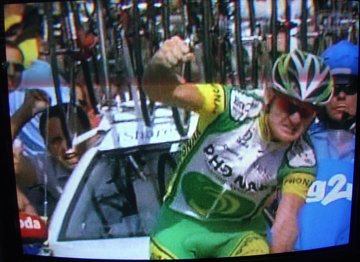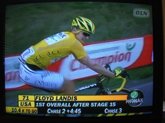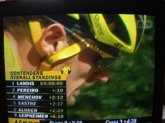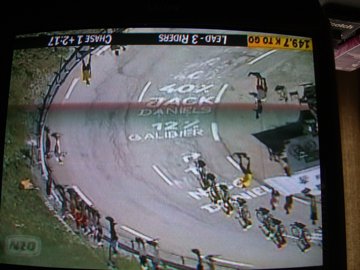
The found poetry — I didn’t say good poetry — in today’s Tour de France Stage 9 race call by Phil Liggett. Someone has actually put together a book of Liggett found poetry, but I think the genre was actually created with the publication of “O Holy Cow,” a book that captures some of the Homer-meets-James Joyce flights of Yankee Hall of Fame shortstop and former broadcaster Phil Rizzuto. But that’s baseball. Let’s get back to the bicycle race.
The recap: It was a tough mountain stage, the last day in the Alps for this year’s tour. A five-man breakaway, driven largely by Discovery’s Yaroslav Popovych, led over the early climbs and stayed a couple minutes ahead of the group including yellow jersey Michael Rasmussen heading onto the lower slopes of the Col du Galibier, a brutal 18-kilometer climb that tops out at about 8,000 feet above sea level. Between the leaders and the Rasmussen group was a single rider, Mauricio Soler, of Colombia. If you heard of him before today, you’re either his mother or father, his coach, or you’ve read the Tour de France guidebook cover to cover. Soler — Liggett lisps his first name, More-RITH-ee-oh — caught the breakaways on the 8 or 9 percent slope of the Galibier and blew by them. Only Popovych and his teammate, Alberto Contador, were able to respond, but Soler shot across the pass more than a minute ahead of them. He stayed away all the way to the end, a beautiful solo effort that concluded with a sharp climb on the race’s final kilometer.
Now, let’s turn it over to Phil:
As Soler caught the breakaway: “These guys must be saying, ‘Who is this man with the long, thin legs?’ ”
As Soler pulled away from Popovych: “Look at this boy now! He’s itching to get on with the race and he’s only 24 years of age.”
As Soler neared the top of the col: “He climbs like a spider, but he also climbs like an angel as he races up this climb.”
As Soler neared the final descent and climb in the finishing town: “These are desperate moments. We are into Briançon. It is dangerous now. These corners duck and dive and they switch back; they descend very steeply, and then it’s a horrible sight when they come ’round a corner and the road just goes up to the heavens to the finishing line.”
Technorati Tags: cycling, tour de france




